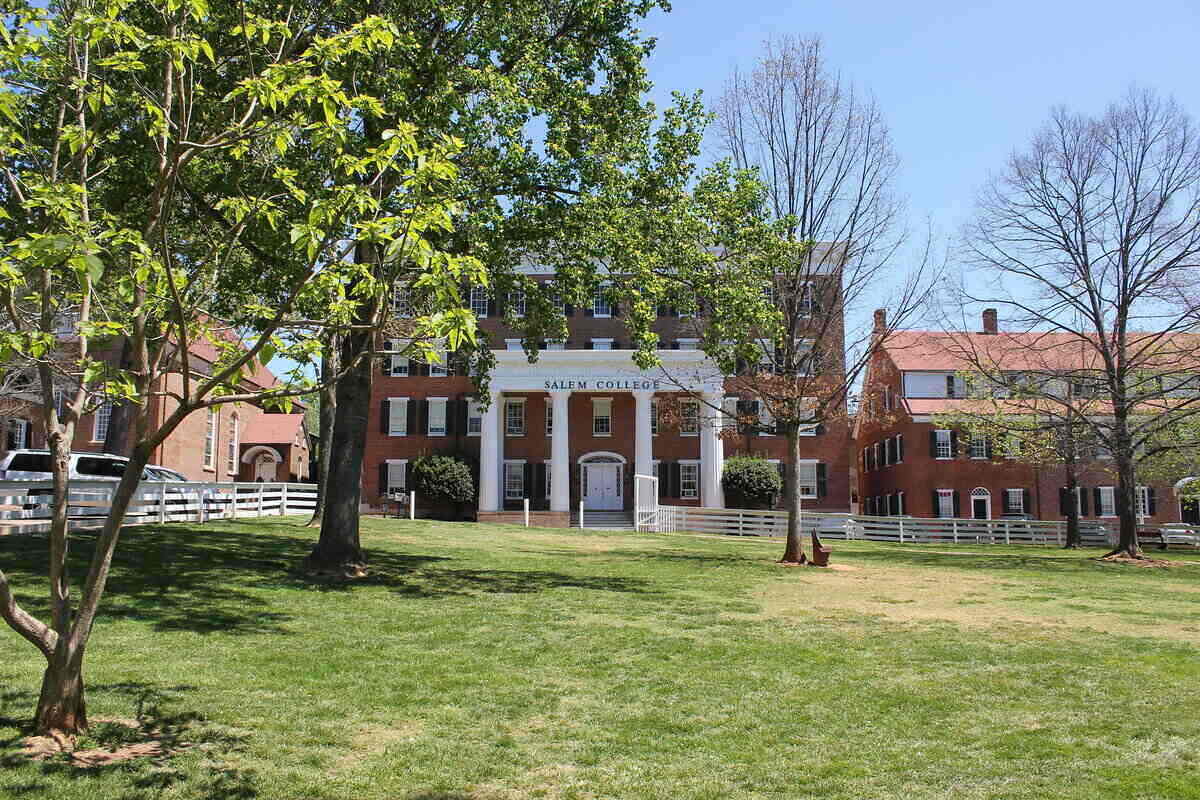
Thanks to Central North Carolina’s cold winters and hot summers, you can grow just about any kind of grass here. Homeowners in this region are absolutely spoiled for choices when it comes to replacing dead lawns or planting grass for new construction.
With so many options, how can you tell which lawn would be best for you? Read on to learn the optimal growing conditions and other qualities of the best grass types for the Piedmont Triad area.
The Piedmont Triad in the transition zone
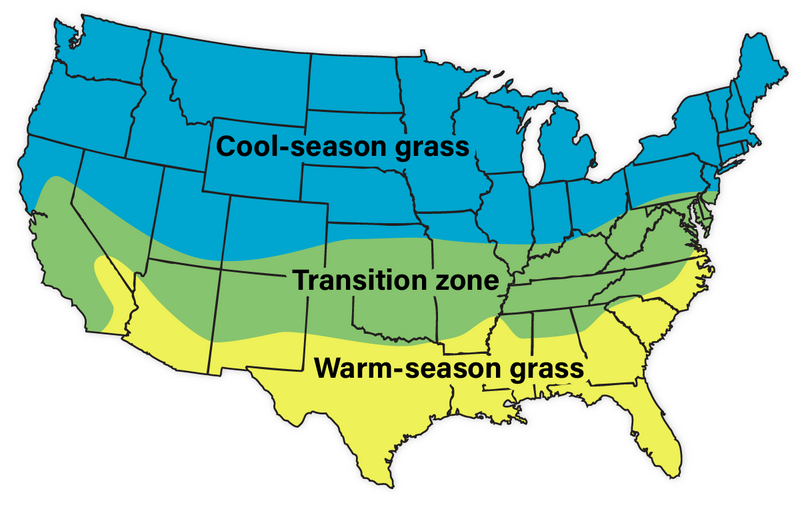
You get to choose between so many different grass types because the Piedmont Triad sits in what’s called the transition zone.
If the United States was an Oreo cookie, the transition zone would be the cream in the middle. To the north, only cool-season grasses will grow. To the south, only warm-season grasses will grow. But here in the gooey center of the country, either grass type can thrive.
What’s the difference between cool-season and warm-season grasses?
- Cool-season grasses grow actively in early spring and fall, when temperatures stay around 55 to 75 degrees Fahrenheit, and go dormant in summer.
- Warm-season grasses grow actively in late spring and summer, when temperatures stay around 75 to 95 degrees Fahrenheit, and go dormant in winter.
Even though you get to choose essentially any grass type you want, there’s a pretty big downside to growing grass in the transition zone. You’ll have a hard time keeping your lawn green year-round because warm-season grasses struggle with colder winters and cool-season grasses struggle with hotter summers.
4 cool-season grass types for the Piedmont Triad
In the Piedmont region of North Carolina, cool-season grasses typically stay green throughout winter but show signs of stress in the heat of summer. They will go dormant and turn brown if the temperature rises higher than 90 degrees Fahrenheit.
Because they can’t stand the heat, cool-season lawns need more water during summer than their warm-season counterparts. Higher water usage could become a problem with 60% of North Carolina in a moderate drought (at the time of this publication).

Matt Lavin Flickr | CC BY-SA 2.0
1. Fine fescue
Fine fescue can refer to several fine-textured grass species, including creeping red fescue, Chewings fescue, hard fescue, and sheep fescue. All these grasses thrive in shade and may not survive in full sun because of the Piedmont Triad’s 80+ degree summer temperatures.
Homeowners often choose to mix fine fescue seed with other cool-season grasses (usually Kentucky bluegrass or tall fescue) to make the other grasses more shade-tolerant and to help fine fescue spread, since most varieties can’t spread on their own.
- Spreads by: Bunch-type grasses that don’t spread; except creeping red fescues, which spread through rhizomes (below-ground stems)
- Drought tolerance: High
- Foot traffic tolerance: Low
- Shade tolerance: High; most shade-tolerant turfgrass type
- Maintenance needs: Generally low-maintenance; don’t need much watering, fertilizing, or pest control
- Recommended mowing height: 1.5-4 inches, depending on the exact species
Grass Seed Options:
– Outsidepride Legacy Fine Fescue Grass Seed (5 lbs.)
– Eretz Creeping Red Fine Fescue Seed (choose your size)
– Outsidepride Creeping Red Fine Fescue Grass Seed (25 lbs.)
– Outsidepride Hard Fine Fescue Grass Seed (10 lbs.)

Brenda Ryan | Lawn Love
2. Kentucky bluegrass
Kentucky bluegrass (KBG) is one of the most popular cool-season grasses in North Carolina and throughout the northern United States. People love it for its attractive look, with a dark green color and medium texture, and its ability to spread and recover from damage or stress.
KBG may not do so well planted on its own in NC’s Piedmont region, but it can improve turfgrass mixes. It’s often mixed with fine fescues or tall fescue to increase its shade, heat, and drought tolerance and to increase the traffic tolerance of the fescues.
- Spreads by: Uses rhizomes to spread rapidly
- Drought tolerance: Moderate; may require weekly watering during extended dry periods
- Foot traffic tolerance: High
- Shade tolerance: Usually grows best in full sun; some varieties can tolerate shade
- Maintenance needs: High-maintenance compared to other grass types; requires regular fertilization and watering to grow its best and often needs weed and pest control
- Recommended mowing height: 1.5-2.5 inches on its own or mixed with fine fescues; 2.5-3.5 inches mixed with tall fescue
Grass Seed Options:
– Jonathan Green (11970) Blue Panther Kentucky Bluegrass Grass Seed (3 lbs.)
– SeedRanch Midnight Kentucky Bluegrass Seed (5 lbs.)
– Jacklin Seed – Biltmore Blue Blend – 100% Kentucky Bluegrass (5 lbs.)

iSstock
3. Perennial ryegrass
In North Carolina, homeowners typically use perennial ryegrass for winter color in the lawn. It has the benefit of establishing quickly, so it’s great for new lawns, but it does not spread once established. That means it can’t repair damaged or dead patches without reseeding.
Perennial ryegrass is very similar to KBG in appearance. For this reason, KBG seed is often added to perennial ryegrass for a more damage-resistant lawn.
- Spreads by: Bunch-type grass that does not spread
- Drought tolerance: Low
- Foot traffic tolerance: Moderate; difficult to kill the turf with traffic but it won’t repair damage on its own
- Shade tolerance: Low
- Maintenance needs: Moderate on its own but higher-maintenance when mixed with KBG
- Recommended mowing height: 2.5-3 inches on its own; 1.5-2.5 inches mixed with KBG
Grass Seed Options:
– Outsidepride Perennial Ryegrass Seed (5 lbs.)
– Eretz ProTurf Perennial Ryegrass Fine Lawn Seed (choose your size)

Ty Haller | Flickr | CC BY-SA 2.0
4. Tall fescue
Tall fescue is low-maintenance and hardy, making it a favorite grass type for many North Carolina homeowners. It tolerates heat and drought better than other cool-season grasses, so it gives you the best chance of keeping a cool-season lawn green through summer. It also grows in partial shade and is disease resistant.
The downside of tall fescue is that it doesn’t spread on its own. It’s difficult to damage, but if a patch does die, you’ll have to reseed it. Alternatively, you can plant KBG seed with tall fescue, and the KBG will spread to fill in any gaps.
- Spreads by: Bunch-type grass that doesn’t spread
- Drought tolerance: High
- Foot traffic tolerance: Moderate; difficult to kill the turf with traffic but it won’t repair damage on its own
- Shade tolerance: High
- Maintenance needs: Low-maintenance; survives with little care and rarely has issues
- Recommended mowing height: 3-3.5 inches
Grass Seed Options:
– Triple-Play Tall Fescue Grass Seed Blend (5000 sq ft)
– Eretz Kentucky 31 K31 Tall Fescue Grass Seed (choose your size)
– Pennington The Rebels Tall Fescue Grass Seed Mix (7 lb.)
5 warm-season grass types for the Piedmont Triad
Warm-season grasses are the opposite of cool-season grasses. They grow actively and look great throughout summer only to go dormant at the first frost of the year and stay brown until the weather warms up again in spring.
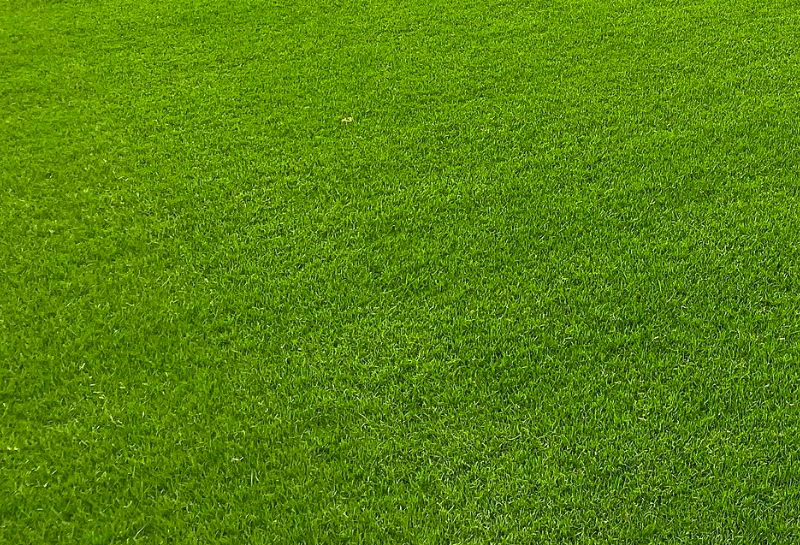
Gilba Solutions Pty Ltd | Wikimedia Commons | CC BY-SA 4.0
1. Bermudagrass
Bermudagrass is an excellent choice for yards that get a lot of foot and vehicle traffic because it forms a thick, durable carpet of a lawn and spreads rapidly, so it can fill in dead or damaged patches on its own. The problem is bermudagrass spreads so aggressively that it will invade flower beds and other cultivated areas if you don’t mow it often and keep it contained.
In addition to its high traffic tolerance, bermudagrass tolerates drought, heat, salty soils or air, and nutrient-poor sandy soils.
- Spreads by: Spreads aggressively using stolons (above-ground stems) and rhizomes
- Drought tolerance: High
- Foot traffic tolerance: High traffic tolerance during active growth periods but suffers from heavy traffic in winter
- Shade tolerance: None; only grows in full sun
- Maintenance needs: Common bermuda is low-maintenance; hybrid varieties need regular fertilizing and frequent mowing
- Recommended mowing height: 1-2 inches
Grass Seed Options:
– Pennington Bermudagrass Bare Spot (5 lb. bag)
– Pennington Smart Seed Bermudagrass Mix (8.75-lb. bag)
– Scotts Turf Builder Bermudagrass (10-lb. bag)
– Hancock Seed Co. Bermudagrass (50-lb. bag)

Forest and Kim Starr | Flickr | CC BY 2.0
2. Carpetgrass
Carpetgrass can grow in soils where other grass types may struggle, including acidic soils and poorly drained soils that stay wet for long periods of time. It also can grow in shade, although it performs best in full sunlight. However, carpetgrass is sensitive to drought, cold weather, salty soils, and heavy traffic.
In color, carpetgrass ranges from a medium bright green to a greenish-yellow. It can spread to repair damage, but it grows slowly and will take longer to fill in holes than a fast spreader such as Bermuda or Zoysia.
- Spreads by: Spreads slowly through stolons
- Drought tolerance: Low
- Foot traffic tolerance: Low
- Shade tolerance: Moderate; grows in partial shade but prefers full sun
- Maintenance needs: Low-maintenance; thrives with just one fertilizer application per year and needs only infrequent mowing because it grows so slowly
- Recommended mowing height: 1.5-2 inches
Grass Seed Option:
Carpetgrass seeds (coated). (2 lbs.)
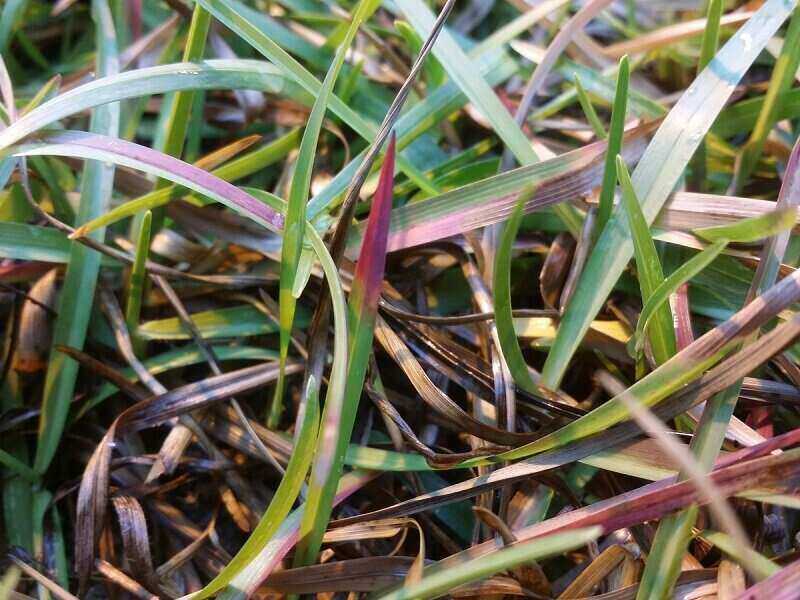
Pxhere
3. Centipedegrass
Centipedegrass is similar to carpetgrass in many ways. It’s low-maintenance, shade-tolerant, a slow grower, and it spreads using stolons. The two even look similar, with a light green color and coarse texture.
Centipedegrass is a little more sensitive, though. Like carpetgrass, centipedegrass doesn’t do well in drought or in areas with lots of traffic. It’s sensitive to many other conditions, as well, including high soil pH, compacted soil, high phosphorus levels in soil, too much thatch, and some herbicides used for weeds.
- Spreads by: Spreads through stolons, but growth is slow
- Drought tolerance: Moderate; will go dormant in periods of severe drought but bounces back quickly from drought stress
- Foot traffic tolerance: Low
- Shade tolerance: Moderate; prefers full sun; grows in partial shade but doesn’t tolerate heavy shade
- Maintenance needs: Low-maintenance; survives with little watering and fertilizing
- Recommended mowing height: 1-2 inches
Grass Seed Options:
– Gulf Kist Coated Centipedegrass Seeds (1 lb.)
– Scotts EZ Seed Patch and Repair Centipedegrass (3.75 lbs.)
– TifBlair Centipedegrass (5-lb. bag)
– Pennington Centipedegrass and Mulch (5-lb. bag)
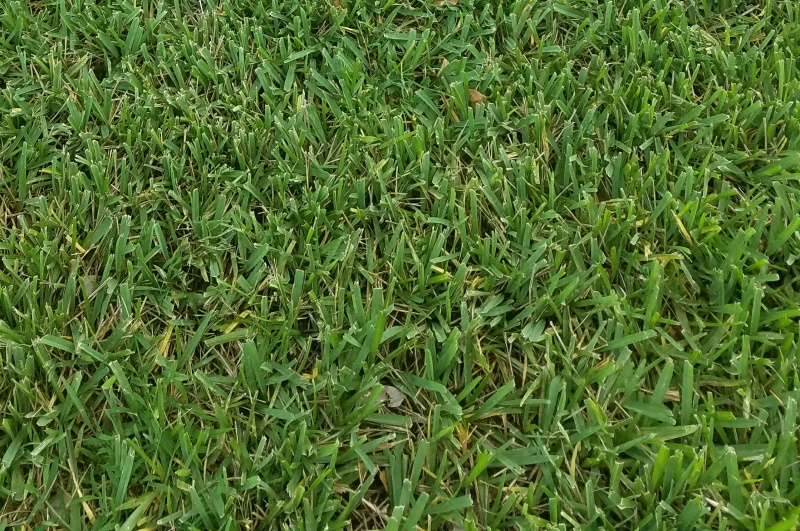
Michelle Selzer | Lawn Love
4. St. Augustinegrass
St. Augustinegrass grows quickly, which means a lush lawn, but it also means more frequent mowing. Standard varieties should be kept relatively tall, but there are dwarf varieties if you like the dark green color and medium texture of St. Augustinegrass but want a shorter lawn.
The biggest issue with St. Augustinegrass in the Piedmont Triad area is its cold tolerance (or lack thereof). St. Augustinegrass is the least cold-tolerant turfgrass and will absolutely turn brown in winter. There’s one cultivar (called “Raleigh”) designed with better cold tolerance for climates like Central North Carolina’s.
- Spreads by: Stolons
- Drought tolerance: Low; requires regular watering in periods without rain
- Foot traffic tolerance: Low
- Shade tolerance: Moderate; some cultivars grow better in shade than others
- Maintenance needs: High-maintenance compared to other grass types; requires regular watering and fertilizing for robust growth and needs frequent mowing because it grows so fast
- Recommended mowing height: 2.5-4 inches, depending on the cultivar (shorter for dwarf varieties and taller for standard varieties)
Grass Plug Options:
– Seed Ranch St Augustine Seville Grass Plugs (2 Trays)
– Seed Ranch St Augustine Floratam Grass Plugs (2 Trays)
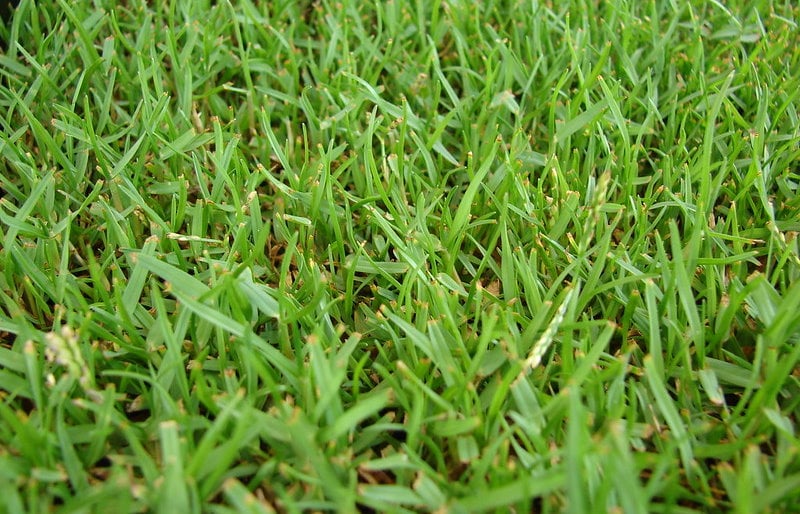
Forest and Kim Starr | Flickr | CC BY-SA 2.0
5. Zoysiagrass
Zoysiagrass is another good grass type for lawns with heavy traffic because of its ability to spread and repair itself quickly. Plus, this grass forms an extremely dense mat that resists damage from traffic in the first place.
There are many different species and cultivars of Zoysiagrass available, some with faster or slower growth rates than the norm and some with coarser or finer textures. Some types are more cold-tolerant, as well.
- Spreads by: Stolons and rhizomes
- Drought tolerance: Low; requires supplemental watering during dry periods
- Foot traffic tolerance: High
- Shade tolerance: Moderate; prefers full sun but can sometimes grow in partial shade
- Maintenance needs: High-maintenance compared to other grass types; requires watering during drought and regular fertilizing throughout the year, plus frequent pest control treatments to prevent common lawn pests
- Recommended mowing height: Depends on the species; anywhere from 0.25-2.5 inches
Grass Plug and Seed Options:
– Zoysia Plugs (50 Large Grass Plugs)
– Zoysia Plugs (50 Full & Lush Grass Plugs)
– Zoysia Plugs (100 Plugs)
– Zoysia Emerald Grass Seeds (1/8 lb. of seeds)
– Zenith Zenith Grass Seeds (1/8 lb. of seeds)
FAQ about grass types for the Piedmont Triad
- What is the most low-maintenance grass type?
- Cool-season: Tall fescue
- Warm-season: Carpetgrass
- What is the best grass type for shade?
- Cool-season: Fine fescue
- Warm-season: Carpetgrass
- What is the best grass type for a high-traffic yard?
- Cool-season: Kentucky bluegrass
- Warm-season: Zoysiagrass
- What grass type uses the least water?
- Cool-season: Tall fescue
- Warm-season: Bermudagrass
How to take care of your new lawn
By choosing one of the best grass types for the Piedmont Triad area, you’re starting your new lawn off on the right track. But planting the grass is only step one of many. For as long as you want your lawn to stay green and healthy, you’ll have to help it through every season.
In springtime, implement our spring lawn care tips for the Piedmont Triad, which include advice for both cool-season and warm-season grasses. Then, in fall, prepare your lawn for winter by following our fall lawn care checklist for the Piedmont Triad.
Remember that in the transition zone, your cool-season lawn may need some extra TLC to get through summer, or your warm-season lawn may need a leg-up from you in winter. Either way, don’t be alarmed if your grass turns brown during its dormant season — it will come back to life once active growth begins again!
Too busy to follow our lawn care advice? Call one of Lawn Love’s Piedmont Triad lawn care experts to keep the grass green for you.
Main Photo Credit: Nicolas Henderson | Flickr | CC BY 2.0
Lawn Love participates in the Amazon Services LLC Associates Program, an affiliate advertising program. Lawn Love may earn revenue from products promoted in this article.